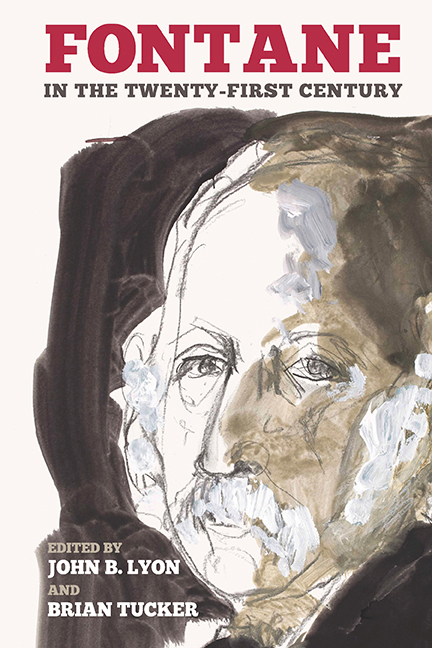Book contents
- Frontmatter
- Contents
- Acknowledgments
- Note on Editions
- Introduction: Fontane in the Twenty–First Century
- 1 Narrative Digression and the Transformation of Nationhood in Vor dem Sturm
- 2 Nasty Women: Female Anger as Moral Judgment in Grete Minde and Effi Briest
- 3 Performing the Philistine: Gossip as a Narrative Device and a Strategy for Reflection on Anti-Semitism in Theodor Fontane's L'Adultera
- 4 To Have an Eye: Visual Culture and the Misapprehension of Class in Irrungen, Wirrungen
- 5 Fontane as a Pacifist? The Antiwar Message in Quitt (1890) and Fontane's Changing Attitude to Militarism
- 6 Disjunctive Transnationalisms in Fontane's Frau Jenny Treibel
- 7 On the “Right Measure” in Effi Briest: Ethics and Aesthetics of the Prosaic
- 8 Transfiguration, Effect, and Engagement: Theodor Fontane's Aesthetic Thought
- 9 Fontane and World Literature: Prussians, Jews, and the Specter of Africa in Die Poggenpuhls
- 10 Von Zwanzig bis Dreißig: The Male Author in Parts
- 11 Melusine von Barby's Barriers and Connections in Fontane's Der Stechlin
- 12 Senescence and Fontane's Der Stechlin
- Notes on the Contributors
- Index
11 - Melusine von Barby's Barriers and Connections in Fontane's Der Stechlin
Published online by Cambridge University Press: 31 August 2019
- Frontmatter
- Contents
- Acknowledgments
- Note on Editions
- Introduction: Fontane in the Twenty–First Century
- 1 Narrative Digression and the Transformation of Nationhood in Vor dem Sturm
- 2 Nasty Women: Female Anger as Moral Judgment in Grete Minde and Effi Briest
- 3 Performing the Philistine: Gossip as a Narrative Device and a Strategy for Reflection on Anti-Semitism in Theodor Fontane's L'Adultera
- 4 To Have an Eye: Visual Culture and the Misapprehension of Class in Irrungen, Wirrungen
- 5 Fontane as a Pacifist? The Antiwar Message in Quitt (1890) and Fontane's Changing Attitude to Militarism
- 6 Disjunctive Transnationalisms in Fontane's Frau Jenny Treibel
- 7 On the “Right Measure” in Effi Briest: Ethics and Aesthetics of the Prosaic
- 8 Transfiguration, Effect, and Engagement: Theodor Fontane's Aesthetic Thought
- 9 Fontane and World Literature: Prussians, Jews, and the Specter of Africa in Die Poggenpuhls
- 10 Von Zwanzig bis Dreißig: The Male Author in Parts
- 11 Melusine von Barby's Barriers and Connections in Fontane's Der Stechlin
- 12 Senescence and Fontane's Der Stechlin
- Notes on the Contributors
- Index
Summary
Elementary Connections
FONTANE's LAST NOVEL, Der Stechlin (The Stechlin, 1898), has as its central idea “den großen Zusammenhang der Dinge” (17:320), translated by William Zwiebel as “the great interrelatedness of things.” The semantics of the German “Zusammenhang,” however, also allows for an understanding of the term as “interconnectedness” or “interconnectiveness.” Indeed Der Stechlin, in depicting interrelations, deals with the connections among the various elements and dimensions of the world: the small and great, near and far, low and high, old and new, nature and society or technology. All this is embodied by the central symbol of Lake Stechlin and its subterranean communications with the world's volcanoes. The natural lake finds its complement in the social sphere in telegraphic networks, which by the end of the nineteenth century connected the world and whose communications are, likewise, invisible transmissions. Telegraphy's medium, “elektrische[r] Strom” (17:29; electric current, Z, 18), connects it metaphorically back to the realm of nature and Fontane's central imagery of water (the medium of connectivity and fluidity). The telegraphic principle also allows Fontane to establish meaningful connections between seemingly distant or otherwise unconnected points in the novel.
Telegraphy, as a modern technology, represents interconnectedness as a quality and product of industrialized society, while the lake and the flow of water embody it in nature. Countess Melusine von Barby is the figure in the novel associated most closely with the lake and nature. While she is a lady of society, her first name, Melusine, is that of the fairy-tale water sprite. She is thus connected to the lake and the imagery of water that pervades the narrative. Through her dual affiliation (both to nature via the lake and water and to society), she represents the principle of interconnectedness itself. And as a sophisticated lady, intelligent, imaginative, sensitive, and urbane, she figures in the novel as a partial alter-ego to the author, as an “allegory of the esthetic mindset,” and, arguably, as an embodiment of Fontane's art and its own art of connecting. It is appropriate, then, that Fontane lets her proclaim the novel's central message: the importance of recalling the great interrelatedness of things (17:320).
- Type
- Chapter
- Information
- Fontane in the Twenty-First Century , pp. 213 - 231Publisher: Boydell & BrewerPrint publication year: 2019



